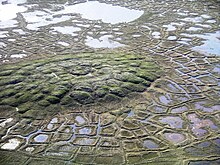
Periglaciation (adjective: "periglacial", referring to places at the edges of glacial areas) describes geomorphic processes that result from seasonal thawing and freezing, very often in areas of permafrost. The meltwater may refreeze in ice wedges and other structures.[1][2] "Periglacial" originally suggested an environment located on the margin of past glaciers. However, freeze and thaw cycles influence landscapes also outside areas of past glaciation.[3] Therefore, periglacial environments are anywhere when freezing and thawing modify the landscape in a significant manner.[4]
- ^ Murck, Barbara (2001). Geology; A Self-teaching Guide. New York, New York: John Wiley & Sons, Inc. ISBN 0-471-38590-5.
- ^ Slaymaker, O. (2011). "Criteria to Distinguish Between Periglacial, Proglacial and Paraglacial Environments". Quaestiones Geographicae. 30 (1): 85–94. Bibcode:2011QGeo...30a..85S. doi:10.2478/v10117-011-0008-y.
- ^ Zhang, Ting; Li, Dongfeng; East, Amy E.; Walling, Desmond E.; Lane, Stuart; Overeem, Irina; Beylich, Achim A.; Koppes, Michèle; Lu, Xixi (1 November 2022). "Warming-driven erosion and sediment transport in cold regions". Nature Reviews Earth & Environment. 3 (12): 832–851. Bibcode:2022NRvEE...3..832Z. doi:10.1038/s43017-022-00362-0.
- ^ Pidwirny, M (2006). "Periglacial Processes and Landforms". Fundamentals of Physical Geography.